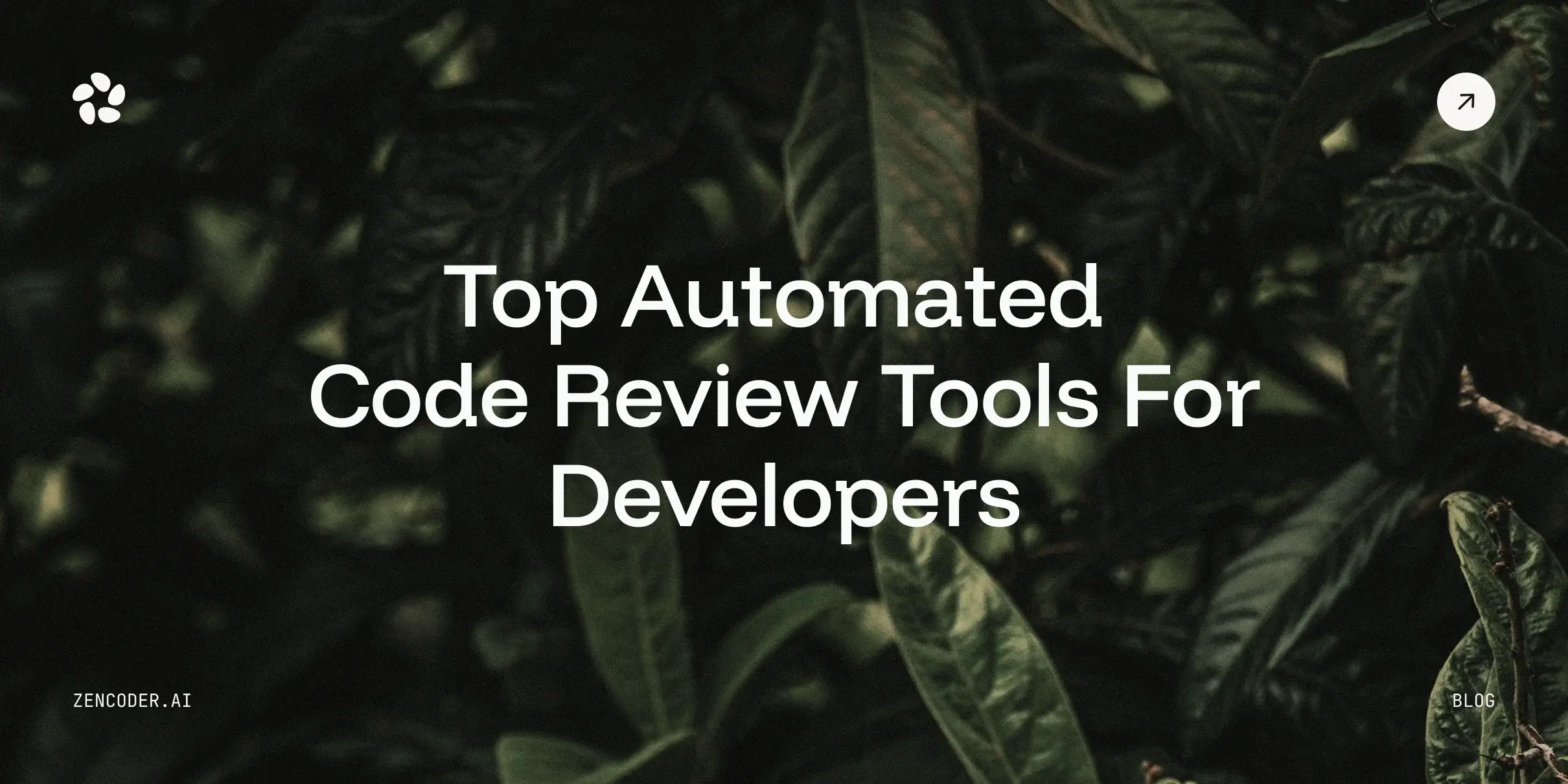Artificial Intelligence is revolutionizing software development.
AI has proven instrumental in ensuring code quality, reducing bugs, and expediting the development process by automating repetitive tasks.
With the integration of AI, code pipelines benefit significantly, especially given the advanced Machine Learning models that can understand context better and help mitigate the hallucination issues associated with Large Language Models (LLMs).
Ensuring code quality is essential.
1. Automated Code Review
Automated code review leverages AI-driven tools to enhance software accuracy, streamline development, and ensure higher code quality. Machine learning models analyze code, identify flaws, and suggest improvements with minimal human intervention, accelerating the code review process significantly.
One significant advantage of AI in code review is its ability to perform "context-aware" analysis. Unlike traditional static code analysis tools, AI-driven systems comprehend the broader application context, ensuring more accurate suggestions. This advanced capability reduces false positives and enhances the reliability of the codebase.
Identifying Bugs Efficiently
AI's integration into the software development lifecycle transforms bug identification, making it faster and more reliable. Utilizing machine learning, AI analyzes code precisely, reducing human errors dramatically.
AI-based tools employ pattern recognition to pinpoint anomalies, efficiently identifying vulnerabilities. This capability ensures quicker detection and remediation of bugs, maintaining a robust codebase.
AI can detect bugs 50% faster than traditional methods.
Moreover, contextual understanding is a key strength of AI. By recognizing the surrounding code context, AI tools minimize false positives, improving the accuracy of bug detection and fostering high-quality software development. This contextual analysis leads to a more dependable and secure codebase.
Consistency in Code Standards
Ensuring consistency in code standards is critical for maintaining high-quality software across various development teams and projects.
AI-driven tools enforce these standards automatically, ensuring uniformity.
They analyze code against predefined guidelines, identifying deviations and providing suggestions for corrections in real time. This process ensures that all code adheres to the set standards, enhancing maintainability, readability, and collaboration.
Furthermore, automated enforcement of coding standards through AI reduces the burden on developers to perform manual code reviews, allowing them to focus on more substantial aspects of the code. These tools can be integrated seamlessly into existing development workflows, providing continuous monitoring and instant feedback. This not only promotes adherence to best practices but also elevates the overall quality and reliability of the software.
2. Predictive Error Detection
Predictive error detection leverages AI to identify potential issues in code before they manifest as bugs.
This proactive approach utilizes machine learning (ML) algorithms to analyze patterns and common mistakes in codebases, offering predictive insights. By identifying anomalies early, developers can address subtle errors that might otherwise lead to significant downstream issues.
Employing AI in this manner enhances both efficiency and accuracy, reducing the time spent on debugging.
Proactive Error Mitigation
Proactive error mitigation refers to the strategy of preventing code errors before they manifest, minimizing the need for reactive fixes.
AI-driven tools play a crucial role in proactive error mitigation.
By employing machine learning to analyze existing codebases, these tools can predict where errors are likely to occur and suggest preventative measures. This continuous vigilance enables developers to correct potential issues during the coding process.
AI also helps in automatically applying hotfixes to the code before it goes live, reducing post-deployment problems. This capability makes it indispensable in DevOps pipelines where the aim is to achieve seamless, error-free deployments. Consequently, organizations leveraging AI for proactive error mitigation often experience higher code quality and reduced maintenance burdens.
Reducing Post-Deployment Issues
AI faciliates better post-deployment stability.
Artificial intelligence proactively identifies and corrects errors during the development cycle. This reduces the likelihood of encountering significant problems once the code is live. AI tools can analyze patterns in historical data, identify outliers, and flag potential bugs before they become critical issues. Consequently, fewer hotfixes are needed post-deployment.
Bug prevention is more effective than bug fixing.
Using AI ensures the detection of subtle issues - the kind that might be missed by human developers - thus contributing to overall code robustness. This advanced analysis effectively minimizes the urgency and frequency of emergency patches.
Moreover, AI-augmented code reviews play a pivotal role in this process. By integrating AI-driven quality checks within continuous integration/continuous deployment (CI/CD) pipelines, organizations can achieve lower defect rates. These AI systems evolve, becoming more proficient at preempting and remedying potential issues, thereby solidifying the reliability and performance of deployed applications.
3. Code Optimization Algorithms
AI-driven code optimization algorithms, a cornerstone of computational advancements, enhance code efficiency. These algorithms not only minimize performance bottlenecks (like Endurance Testing) but also ensure resource utilization is maximized, leading to faster and more reliable software applications.
By leveraging the capabilities of sophisticated machine learning models, AI can predict and implement optimizations that significantly reduce execution time and energy consumption. These integrations, when woven into CI/CD pipelines, ensure that code is not only functional but also optimized to run under various constraints, delivering superior performance.
Enhancing Performance
AI enhances application performance significantly.
AI-driven models analyze code to detect inefficiencies. This early detection allows for proactive remediation, making applications more efficient and responsive. Consequently, development cycles are shortened, leading to faster time-to-market while maintaining a high standard of performance. Efficiency gains translate into cost savings and higher user satisfaction.
Performance margins become substantial.
Implementing AI solutions aids in identifying potential performance issues - such as memory leaks or redundant operations - at an early stage, ensuring code sustains optimal performance. This proactive approach enhances long-term maintainability and user experience.
Furthermore, AI's capability to continuously learn and adapt means systems can evolve to handle new performance challenges dynamically. Leveraging AI in performance tuning not only bolsters current systems but also fortifies them against future demands.
Minimizing Resource Usage
AI also plays a pivotal role in minimizing resource usage, which in turn reduces operational costs. Efficient resource management is critical, particularly in large-scale applications.
AI-driven optimization focuses on refining the codebase.
For instance, machine learning algorithms can predict redundant calculations and suggest more efficient alternatives. This reduces CPU and memory usage substantially.
Additionally, AI can dynamically manage resource allocation based on real-time demands. By adapting to fluctuations, it ensures optimal usage without overprovisioning.
These enhancements not only optimize server workload but also reduce energy consumption, contributing to greener computing practices. In cloud environments, this translates to lower bills and improved scalability.
Ultimately, the use of AI ensures that application resources are utilized as efficiently as possible. Development teams benefit from this efficiency, gaining robust applications with minimized overhead.
4. Adaptive Learning Systems
Adaptive learning systems dynamically tailor code suggestions to developers' unique styles and habits, enhancing overall efficiency.
Such systems leverage advanced machine learning (ML) models to identify patterns and discrepancies in coding practices, offering real-time corrective feedback. This integration not only accelerates the debugging process but also upskills developers by exposing them to best practices continuously.
By learning from each interaction, adaptive learning systems ensure that the AI evolves along with the developer.
Continuous Improvement
Continuous improvement is essential in modern software development.
Scheduling regular assessments can elevate code quality. AI tools excel in this domain by facilitating continuous monitoring and analysis, thereby enabling an ongoing cycle of enhancements. Features, such as code suggestions and error detection, provided by AI-driven platforms, ensure that even minor issues are addressed promptly.
AI consistently learns and evolves.
By using historical data to understand common pitfalls and areas requiring enhancement, AI systems can provide valuable insights. These insights help development teams prioritize their efforts and focus on impactful areas first.
Moreover, the iterative nature of AI contributes significantly to the long-term success of software projects. Continuous feedback loops allow AI to become increasingly adept at identifying and eliminating defects, leading to a perpetually advancing codebase that adheres to the highest quality standards.
Tailoring Solutions to Projects
Customizing AI tools to the unique needs of specific projects is vital for maximizing their effectiveness.
Each software project has its distinct requirements, constraints, and objectives, which necessitates a tailored approach to integrating AI for code quality assurance. Understanding the project's context ensures that AI recommendations are relevant and actionable.
For instance, a web application may prioritize front-end code optimizations and user interface improvements, whereas an enterprise backend system might need robust security and data integrity checks. Different project needs call for customized AI solutions that align with their specific goals.
Therefore, deploying AI in a way that complements the existing workflow and technology stack can enhance developer productivity and code quality. Incorporating tailored AI solutions into the development pipeline ensures that contextual nuances are considered, reducing the risk of irrelevant or inaccurate code suggestions.
In summary, aligning AI capabilities with project-specific requirements guarantees a more effective and meaningful code quality improvement process.


![9 Stackblitz Alternatives to Consider [2026 Comparison List]](https://zencoder.ai/hubfs/Cover-Dec-16-2025-01-04-58-6323-PM.webp)

